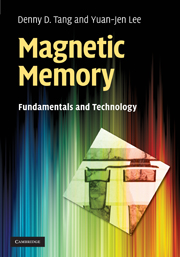Book contents
- Frontmatter
- Contents
- Preface
- Acknowledgments
- 1 Basic electromagnetism
- 2 Magnetic films
- 3 Properties of patterned ferromagnetic films
- 4 Magnetoresistance effects
- 5 Field-write mode MRAMs
- 6 Spin-torque-transfer mode MRAM
- 7 Applications of MTJ-based technology
- Appendix A Unit conversion table for cgs and SI units
- Appendix B Dimensions of units of magnetism
- Appendix C Physical constants
- Appendix D Gaussian distribution and quantile plots
- Appendix E Weibull distribution
- Appendix F Time-dependent dielectric breakdown (TDDB) of magnetic tunnel junction devices
- Appendix G Binomial distribution and Poisson distribution
- Appendix H Defect density and the breakdown/TMR distribution of MTJ devices
- Appendix I Fe, Ni and Co material parameters
- Appendix J Soft error, hard fail and design margin
- Index
- References
7 - Applications of MTJ-based technology
Published online by Cambridge University Press: 06 July 2010
- Frontmatter
- Contents
- Preface
- Acknowledgments
- 1 Basic electromagnetism
- 2 Magnetic films
- 3 Properties of patterned ferromagnetic films
- 4 Magnetoresistance effects
- 5 Field-write mode MRAMs
- 6 Spin-torque-transfer mode MRAM
- 7 Applications of MTJ-based technology
- Appendix A Unit conversion table for cgs and SI units
- Appendix B Dimensions of units of magnetism
- Appendix C Physical constants
- Appendix D Gaussian distribution and quantile plots
- Appendix E Weibull distribution
- Appendix F Time-dependent dielectric breakdown (TDDB) of magnetic tunnel junction devices
- Appendix G Binomial distribution and Poisson distribution
- Appendix H Defect density and the breakdown/TMR distribution of MTJ devices
- Appendix I Fe, Ni and Co material parameters
- Appendix J Soft error, hard fail and design margin
- Index
- References
Summary
Introduction
A short time after the discovery of magnetic tunneling devices, tunneling magnetoresistance (TMR) replaced giant magnetoresistance (GMR) read sensor in the hard disk drive. This marked the first successful commercialization of magnetic tunnel junction technology. The first mass production of the magnetic recording head based on a MgO tunnel barrier took place in 2006. In the same year, 4 Mb MRAM chips were commercialized, and it was the first field-MRAM product working in the toggle-write mode. The viability of MTJ technology at the product level is proven. Subsequently, electronic system designers started to consider seriously how to take advantage of this technology. Many new applications of MTJ technology begin to emerge. One of the new circuit elements is the non-volatile magnetic flip-flop device, which is used for the reduction of VLSI chip power as well as for run-time system re-configuration. Such new applications can only be realized with the unique properties of magnetic tunnel junction devices.
Other new applications are being explored in the field of healthcare. GMR and TMR chips are used for detecting biological molecules labeled with magnetic particles, and this could be a powerful platform for next-generation diagnostics. The sensitivity achievable with simple portable instrumentation can be orders of magnitude better than the current methods. Since this application is still in its infancy, it will not be discussed further here. Interested readers are referred to the references above.
- Type
- Chapter
- Information
- Magnetic MemoryFundamentals and Technology, pp. 165 - 175Publisher: Cambridge University PressPrint publication year: 2010

